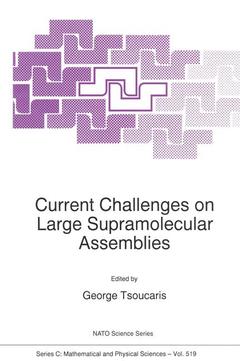Current Challenges on Large Supramolecular Assemblies, 1999 Nato Science Series C: Series, Vol. 519
Langue : Anglais
Coordonnateur : Tsoucaris Georges

The objectives of the ARW were: - identifying areas and highlighting approaches by which large Supramolecular (SM) Assemblies can be synthesised - reviewing and combining methods to characterise and analyse such assemblies. The first part of the ARW is devoted to reviewing synthetic achievements in recent years for several families of SM compounds, and to bringing out principles for crystal structure design, including novel quantum mechanical methods. Synthesis pertains both to the chemical synthesis of components for SM assembly, and to the subsequent assembly process based on complementarity and non-covalent interactions. The elaboration of multiple recognition "algorithms" concurrently employed (for instance, 1t-1t and hydrogen bonds) has recently reached a high degree of sophistication in the sequence: Molecules -7 Supermolecule -7 SM array -7 Crystal or Conglomerate Novel Large Assemblies comprise synthetic entities with molecular weight as high as 15000, and hybrid SM assemblies between synthetic molecules and DNA. Further developments are foreseen at a higher level of organisation, such as between supermolecules or with electromagnetic fields in photochemical processes. Creation of 2D Assemblies is now a powerful tool for creation and study of SM interactions. Moreover, much is to be learned in going from 2D to 3D assemblies in crystal growth and other forms of organisation such as micelles or liquid crystals. On the other hand, crystal engineering based on Molecular Recognition in the Crystal State leads to novel 2D assemblies occurring within predesigned crystal structures (hydrophobic organic clays or nanoporous networks).
Preface. Quantum Chrystallography: Features and Applications; J. Karle, et al. Large Molecular Assemblies Held Together by Non-Covalent Bonds; J.L. Atwood, et al. Synthetic Supramolecular Chemistry; S.J. Cantrill, et al. Beyond Supramolecular Chemistry: Supramolecular and Übersupramolecular Aspects of Chemical Structure and Reactivity: Static and Oscillating Electric and Magnetic Fields, Coherence, and Cooperativity; N.J. Turro. Non-Covalent Synthesis and Characterization of Large Supramolecular Assemblies; D.N. Reinhoudt, et al. Self-Assembling Structures Based on Hydrogen Bonding Subunits; A. Zafar, A.D. Hamilton. Hydrogen Bonds in Organised Monolayers; D. Möbius, et al. Supramolecular Architectures on Liquid Surfaces. From 2-D Assemblies to 3-D Crystals; I. Weissbuch, et al. Supramolecular Synthesis of Organic and Metal-Organic Laminates with Affinity for Aromatic Guests: Hydrophobic Clay Mimics; K. Biradha, et al. `Crystal Engineering' with Two-Dimensional Hydrogen Bonding Networks; J.A. Swift, et al. Recognition of Convex Fullerene Molecules by Concave Complexing Agents. Structure and Reactivity; H.B. Bürgi. The Structure of Solvates in the Solid State-Model Systems for Heteromolecular Association? J. Lipkowski, et al. The Role of Charge Assisted C-Hdelta+-Odelta- and C-Hdelta+-Fdelta- Hydrogen Bonds in Organometallic Crystals; D. Braga, F. Grepioni. Weak Hydrogen Bonds in Supramolecular Synthesis; A. Nangia, G.R. Desiraju. Molecular Tectonics: An Approach to Organic Networks; M.W. Hosseini. MD Simulations on Ions and Ionophores at a Liquid-Liquid Interface: From Adsorption to Recognition; F. Berny, et al. Self-Organization in Molecular Crystals, Liquids and Solutions: Computer Studies;A. Gavezotti, G. Filippini. Gas Hydrates as Self-Assembled Templated Lattices. Towards Time-Resolved Studies of Clathrate Hydrate Formation; J.A. Ripmeester, et al. Study by Electrospray Mass Spectrometry of Large Dendritic Supramolecular Complexes; E. Leize, et al. Advanced Crystallographic Methods: Experimental Electron Densities and the Study of Excited State Structure; P. Coppens. Time Resolved X-Ray Diffraction in Solids and Liquids; I.V. Tomov, et al. Single Molecule Force Spectroscopy with Individual Proteins; J.M. Fernandez, et al. Crystal Solving Procedures Applied to Peptides, Foldamers and Channel Forming Adamantyl/Peptide Hybrid Macrocycles; I.L. Karle. Tetracycline Respressor Acts as a Molecular Switch Regulated by Tetracycline Binding; W. Hinrichs, et al. Esterolytic Catalytic Antibodies; B.S. Green, M. Knossow. Weak Hydrogen Bonding in Cyclodextrin Complex Stabilisation; Th. Steiner, W. Saenger. Cyclodextrins: Towards Large Assemblies for Efficient Slow Release Devices; G. Tsoucaris, N. Rysanek. Influence of the Guest on the Packing of Dimeric &bgr;-Cyclodextrin Complexes; I.M. Mavridis. Semiconductor Nanocrystal Colloids; A.P. Alivisatos. Perspectives in Supramolecular Chemistry: From Molecular Recognition towards Self-Organization; J.-M. Lehn. Index.
Date de parution : 10-2012
Ouvrage de 424 p.
16x24 cm
Disponible chez l'éditeur (délai d'approvisionnement : 15 jours).
Prix indicatif 52,74 €
Ajouter au panierThèmes de Current Challenges on Large Supramolecular Assemblies :
© 2024 LAVOISIER S.A.S.



